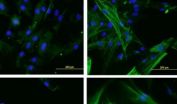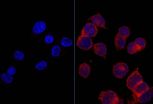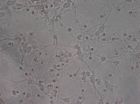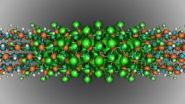(Press-News.org) Scleroderma is a rare and often fatal disease, causing the thickening of tissue, that currently lacks a cure and any effective treatments. A group of researchers, including a Michigan State University professor, is looking to change that.
"Our findings provide a new approach to developing better treatment options where few have existed," said Richard Neubig, chairperson of the Department of Pharmacology and Toxicology in MSU's College of Osteopathic Medicine.
Neubig, along with several of his colleagues from the University of Michigan, have identified the core signaling pathway that activates the disease and the chemical compounds that can turn it off.
"There are two kinds of scleroderma – localized and systemic – with the latter often proving to be life threatening," said Neubig, who helped lead the study. "This research shows that by inhibiting this main signaling pathway, we can block fibrosis – the thickening of tissue that occurs with the disease."
For localized scleroderma patients, this process often happens in the skin resulting in loss of flexibility. Systemic sclerosis has the same effect with variable degree of skin fibrosis, but also can spread throughout the body hardening key organs such as the lungs, heart, gut and kidneys.
Scleroderma is an autoimmune disorder. It's estimated 300,000 Americans suffer from the disease with about one-third of those having the systemic form. Localized scleroderma patients usually live normal lifespans. Yet about half of systemic patients, especially with widespread skin involvement and internal organ fibrosis, will see their lives cut short.
"The majority of drug treatments that exist today for fibrosis basically look at reducing just the inflammation," said Dinesh Khanna, associate professor in the Department of Internal Medicine and director of the Scleroderma Program at the University of Michigan. "There are other drugs that block one or two of the signaling pathways that cause the disease, but scleroderma has many of these pathways."
Neubig agrees and adds that this new research could significantly change the quality of life for scleroderma patients and greatly increase the lifespan of systemic patients.
"Our research shows promise for the development of a new drug that can reverse the fibrosis process by flipping the main switch on all of the signaling pathways," Neubig said. "By validating this core switch as a viable drug target, we can now continue our work to improve the chemical compounds so they will work with doses that are appropriate for people. It's definitely promising."
INFORMATION:
The research was funded through a private donation from Jon and Lisa Rye, a Michigan family who has experienced the effects of scleroderma firsthand. Additional financial support was received through the family's crowdfunding site, the Scleroderma Cure Fund.
The study was co-authored by U-M graduate student Andrew Haak, Department of Pharmacology, along with U-M Medical Center rheumatology researchers Pei-Suen Tsou, Mohammad Amin, Jeffrey Ruth, Phillip Campbell and David Fox, and U-M College of Pharmacy professor Scott Larsen.
The research is published in the Journal of Pharmacology and Experimental Therapeutics.
Michigan State University has been working to advance the common good in uncommon ways for more than 150 years. One of the top research universities in the world, MSU focuses its vast resources on creating solutions to some of the world's most pressing challenges, while providing life-changing opportunities to a diverse and inclusive academic community through more than 200 programs of study in 17 degree-granting colleges.
Flipping the switch on scleroderma
2014-04-04
ELSE PRESS RELEASES FROM THIS DATE:
NASA sees Tropical Depression 05W's bulk west of center
2014-04-04
NASA-NOAA's Suomi NPP satellite passed over Tropical Depression 05W on April 4 at 07:09 UTC/3:09 a.m. EDT. The VIIRS instrument captured a visible picture of the storm, revealing most of the clouds and thunderstorms were west of the center.
The Joint Typhoon Warning Center or JTWC noted that animated multispectral satellite imagery today, April 3, showed that the low-level circulation center is well-defined and that there is fragmented convective banding of thunderstorms wrapping from the north into the southwest, so most of the strongest convection and thunderstorms ...
Researchers probe the next generation of 2-D materials
2014-04-04
As the properties and applications of graphene continue to be explored in laboratories all over the world, a growing number of researchers are looking beyond the one-atom-thick layer of carbon for alternative materials that exhibit similarly captivating properties.
One of these materials is molybdenum disulfide (MoS2), which is part of a wider group of materials known as transition metal dichalcogenides, and has been put forward by a group of researchers in the US as a potential building block for the next generation of low-cost electrical devices.
Due to its impressive ...
Discovery of a mechanism that makes tumor cells sugar addicted
2014-04-04
For almost a hundred years ago is known that cancer cells feel a special appetite for a type of sugar called glucose. The tumor uses this molecule is like the gasoline which depends a sports car to burn faster and grows and multiplies rapidly. It is a little cash process from the energy point of view but allows a superaccelerated cancer cell division. It is what is known as the Warburg effect, which was described in 1927.
Until now little was known about how healthy cells that have a balanced energy consumption depend on this "fast food" calorie in the tumor cell. Today, ...
Vascular changes caused by deep brain stimulation using brain MRI
2014-04-04
Deep brain stimulation has been widely used to treat patients with movement disorders and increasing attention has been paid to its use in the treatment of neurological and psychiatric disorders. However, the influence of subthalamic nucleus or pallidal deep brain stimulation on cerebral vasculature is poorly understood. Even though the metabolic changes caused by deep brain stimulation are being studied using positron emission tomography, the structural changes in cerebral areas like the intracerebral vasculature have not yet been evaluated. Dr. Byeong Sam Choi and colleagues ...
Clinical value of ginsenoside Rb1 against neuronal damage following cerebral ischemia
2014-04-04
Activated microglia-mediated inflammation promotes neuronal damage under cerebral hypoxic-ischemic conditions, so it is likely that inhibiting hypoxia-induced activation of microglia will alleviate neuronal damage. To test this hypothesis, Dr. Lining Ke and co-workers from Southern Medical University and Fujian Medical University in China co-cultured ginsenoside Rb1, an active component of ginseng, and cortical neurons. Their findings indicate that ginsenoside Rb1 attenuates damage to cerebral cortex neurons by downregulation of nitric oxide, superoxide, and tumor necrosis ...
Depression increases heart failure risk by 40 percent
2014-04-04
Stavanger, Norway – 4 April 2014: Moderate to severe depression increases the risk of heart failure by 40%, a study of nearly 63 000 Norwegians has shown. The findings were presented for the first time today at EuroHeartCare 2014.
EuroHeartCare is the official annual meeting of the Council on Cardiovascular Nursing and Allied Professions (CCNAP) of the European Society of Cardiology (ESC). This year's meeting is organised jointly with the Norwegian Society of Cardiovascular Nurses and is held 4-5 April in Stavanger, Norway.
Ms Lise Tuset Gustad, first author of the ...
Tracking sperm whales' ecology through stomach contents
2014-04-04
AMHERST, Mass. – In the largest regional study of its type to date, marine ecologist Michelle Staudinger and colleagues offer better understanding of the feeding ecologies of two very rare sperm whale species in waters off the southeast U.S. coast, adding baseline data they say are important as climate change, fishing and pollution alters the animals' environment and food sources.
"Understanding what resources support populations of these incredibly rare animals is important to conservation," Staudinger, adjunct assistant professor in environmental conservation at the ...
To bridge LEDs' green gap, scientists think small... really small
2014-04-04
Nanostructures half the breadth of a DNA strand could improve the efficiency of light emitting diodes (LEDs), especially in the "green gap," a portion of the spectrum where LED efficiency plunges, simulations at the U.S. Department of Energy's National Energy Research Scientific Computing Center (NERSC) have shown.
Using NERSC's Cray XC30 supercomputer "Edison," University of Michigan researchers Dylan Bayerl and Emmanouil Kioupakis found that the semiconductor indium nitride (InN), which typically emits infrared light, will emit green light if reduced to 1 nanometer-wide ...
Disease-free survival estimates for ovarian cancer improve over time
2014-04-04
SAN DIEGO, April 4, 2014 – The probability of staying disease-free improves dramatically for ovarian cancer patients who already have been disease-free for a period of time, and time elapsed since remission should be taken into account when making follow-up care decisions, according to a study led by researchers at the University of Pittsburgh Cancer Institute (UPCI), a partner with UPMC CancerCenter. The findings will be presented Wednesday at the American Association for Cancer Research (AACR) Annual Meeting 2014.
A patient's prognosis traditionally is determined when ...
A new species of horseshoe worm discovered in Japan after a 62 year gap
2014-04-04
The horseshoe worm is a worm-like marine invertebrate inhabiting both hard and soft substrates such as rock, bivalve shells, and sandy bottom. The name "horseshoe" refers to the U-shaped crown of tentacles which is called "lophophore." Horseshoe worms comprise a small phylum Phoronida, which contains only ten species decorating the bottom of the oceans.
The new species Phoronis emigi, the eleventh member of the group described in the open access journal ZooKeys, comes after a long 62 year gap of new discoveries in the phylum. It is unique in the number and arrangement ...






